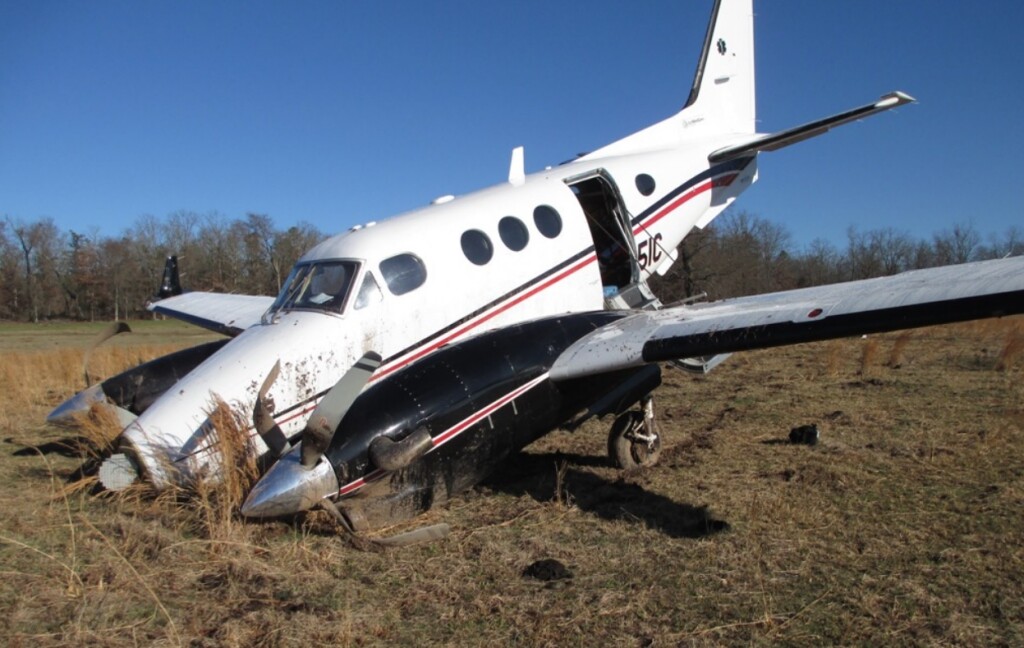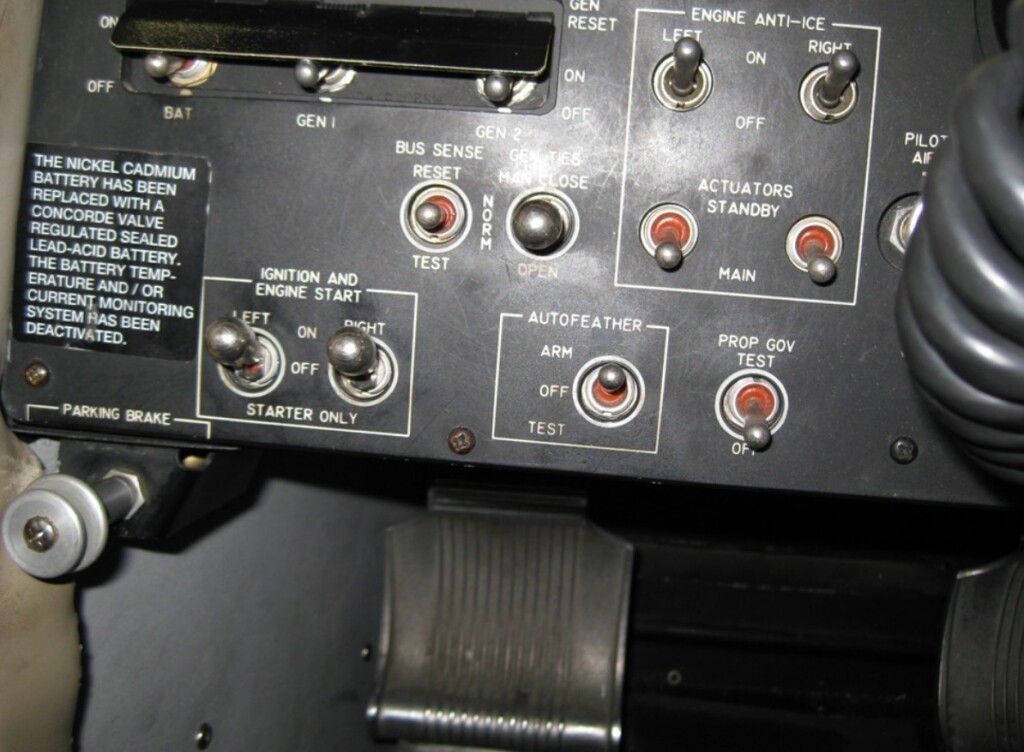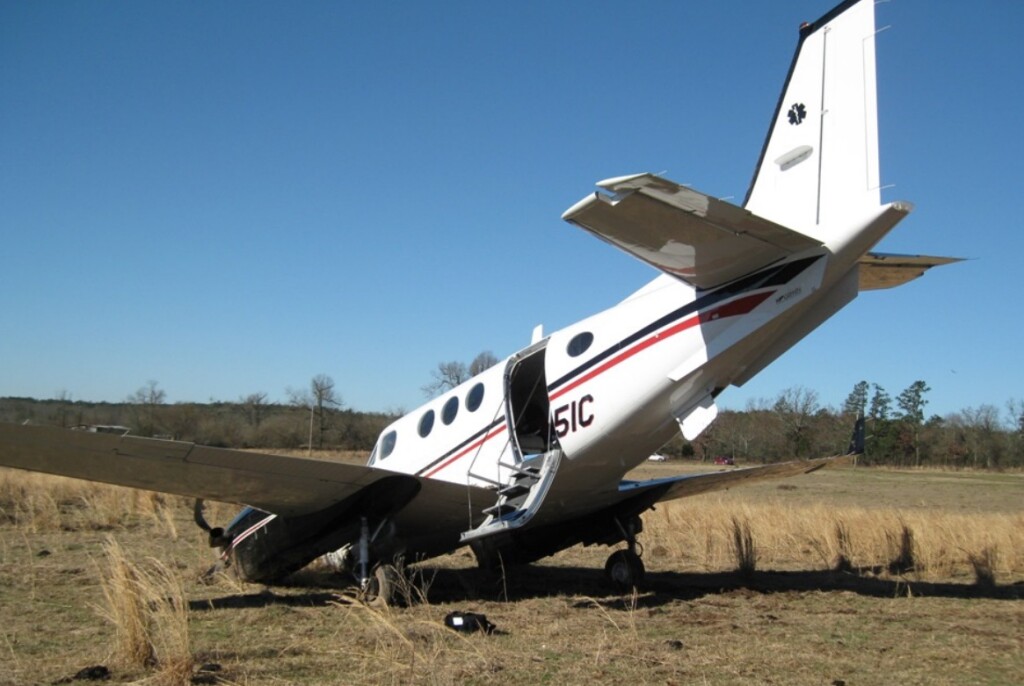Air Ambulance Forced Landing: Fuel and Switch Errors Plus CRM Breakdown (Eaglemed King Air C90A N1551C)
On 14 February 2017 Beechcraft King Air C90A N1551C, an air ambulance operated by Eaglemed, was substantially damaged during a precautionary landing following a loss of power on one engine near Rattan, Oklahoma. The single pilot and two medical personnel aboard were uninjured.
The Accident Flight
The pilot, a 72-year-old male with 22000 flying hours total experience and 400 on type, was phoned at 0710 by the night shift pilot (who was rostered to be on duty to 1000) and asked to come in early to do a patient transfer flight from Idabel, Oklahoma to Paris, Texas. The US National Transportation Safety Board (NTSB) explain in their safety investigation report (issued 10 August 2020) that the aircraft departed McAlester, Oklahoma for Idabel at 0806, but don’t discuss the flight planning or pre-flight.
The pilot stated that the engine start and airplane power-up were normal. The engine ice vanes were lowered, and the de-icing system was activated as required for ground operations. The ice vanes were subsequently raised before takeoff.
Takeoff and climb out were routine, and he subsequently leveled off the airplane at 7,000 ft. mean sea level (msl). The air traffic controller informed him of “heavy rain showers” near the destination airport and he “put the ice vanes down.” Shortly afterward, the airplane experienced two “quick” electrical power fluctuation; “everything went away and then came back.” “Seconds later the entire [electrical] system failed.” Due to the associated loss of navigation capability while operating in instrument meteorological conditions, the pilot set a general course for better weather conditions based upon the preflight weather briefing.
During the attempt to find a suitable hole in the clouds to descend through under visual conditions, the left engine lost power. The pilot ultimately located a field through the cloud cover and executed a single engine precautionary landing [at 1145].
The nose landing gear collapsed, and the airplane sustained substantial damage to the right engine mount and firewall.
NTSB Safety Investigation
In post-accident examination:
The three-position Ignition and Engine Start/Starter Only switches on the cockpit instrument panel were in the ON position. The Engine Anti-Ice switches were in the ON position.
The left- and right-wing fuel tanks did not contain any visible fuel. The left nacelle fuel tank did not contain any visible fuel. The right nacelle fuel tank appeared to contain about one quart of fuel.
During interviews the pilot and medical crew described a remarkable lack of communication and coordination…
The pilot reported that the medical crew became apprehensive as the emergency transpired. On three occasions, as the pilot maneuvered the airplane attempting to locate a hole in the clouds to descend, the medical crew member in the co-pilot seat grabbed the control wheel to keep the pilot from banking the airplane. He subsequently relinquished the control wheel as directed by the pilot. The medical crew attempted to locate the airplane by using cellphones to coordinate with the operator’s operations center or by using the cellphone GPS capability. However, these efforts resulted in multiple course adjustments and ultimately failed to encounter visual meteorological conditions before fuel exhaustion on the left engine.
The medical personnel say pilot was “making some aggressive banks and turns”, being “unresponsive” and refused to turn around to McAlester, Oklahoma. The pilot accused the medical personnel of panicking, failure to divulge critical information (namely the loss of a phone signal), interference and violating FAR 91.11 (Prohibition on Interference with Crew Members). The pilot’s statement however did not explain how the emergency originally developed…
NTSB Safety Analysis
The loss of electrical power was likely initiated by the pilot inadvertently selecting the engine start switches instead of the engine anti-ice (ice vane) switches. This resulted in the starter/generators changing to starter operation and taking the generator function offline. Airplane electrical power was then being supplied solely by the battery, which caused it to deplete and led to a subsequent loss of electrical power to the airplane.
The lack of fuel onboard at the time of the accident is consistent with a loss of engine power due to fuel exhaustion. This was a result of the extended flight time as the pilot attempted to exit instrument conditions after the loss of electrical power to locate a suitable airport. Further, the operator reported that 253 gallons (1,720 lbs) of fuel were on board at takeoff, and the accident flight duration was [expected to be] 3.65 hours. At maximum range power, the expected fuel consumption was about 406 lbs/hour, resulting in an endurance of about 4.2 hours. Thus, the pilot did not have the adequate fuel reserves required for flying in IMC.
Looking at the relatively close locations of McAlester, OK, Idabel, OK and Paris, TX we find an estimate of 3.65 hours very surprising (the accident pilot stated that the night shift pilot could have completed the flight by 1000). Equally, we note the accident occurred after 2 hours 39 mins yet the timing of the electrical power loss is not clear. No FAA radar tracking data is included, and it’s not clear what reaction there was to the non-communicating aircraft. The NTSB also don’t discuss the operator or CRM in any further detail.
NTSB Probable Cause
The loss of electrical power due to the pilot’s inadvertent selection of the engine start switches and the subsequent fuel exhaustion to the left engine as the pilot attempted to locate visual meteorological conditions.
Contributing to the accident were the pilot’s failure to ensure adequate fuel reserves on board for the flight in instrument meteorological conditions and the miscommunication between the pilot and medical crewmembers.
Safety Resources
We have discussed human factors and error management more generally here:
- Professor James Reason’s 12 Principles of Error Management
- Back to the Future: Error Management
- Rockets Sleds, Steamships and Human Factors: Murphy’s Law or Holt’s Law?
- Complacency: A Useful Concept in Safety Investigations?
- Also see our review of The Field Guide to Understanding Human Error by Sidney Dekker presented to the Royal Aeronautical Society (RAeS): The Field Guide to Understanding Human Error – A Review
Also see:
- Survey Aircraft Fatal Accident: Fatigue, Fuel Mismanagement and Prior Concerns
- Fuel Exhaustion Causes EMB-110 Emergency Landing
- UH-1H Fuel Exhaustion Accident
- NASCAR Driver and Pilot Died in Mooney M20C Fuel Starvation FOD Accident
- Canadian KA100 Fuel Exhaustion Accident
- How a Cultural Norm Lead to a Fatal C208B Icing Accident
- Running on Fumes: Fatal Canadian Helicopter Accident
- The Wrong Fuel: Three Misfuelling Accidents
- Turbine Dromader M18A Downed by Fuel Contamination: Shell Detector Capsules Misused
- Singapore Airlines B777 41t Fuel Discrepancy Incident
- Fuel System Maintenance Error: Tuniter ATR72 TS-LBB Ditching 6 August 2005
- Execuflight Hawker 700 N237WR Akron Accident: Casual Compliance
- Unstabilised Approach Accident at Aspen
- Disorientated Dive into Lake Erie
- Wait to Weight & Balance – Lessons from a Loss of Control
- Business Jet Collides With ‘Uncharted’ Obstacle During Go-Around
- G200 Leaves Runway in Abuja Due to “Improper” Handling
- Cockpit Tensions and an Automated CFIT Accident
- Aborted Take Off with Brakes Partially On Results in Runway Excursion
- Global 6000 Crosswind Landing Accident – UK AAIB Report
- Visual Illusions, a Non Standard Approach and Cockpit Gradient: Business Jet Accident at Aarhus
Aerossurance was to have run workshops at the EHA European Rotors VTOL Show and Safety Conference in Cologne in November 2020 on a) Safety Culture and Leadership and b) Contracting Aviation Services: An Introduction to the Basics. Sadly the show has been postponed to 2021.






Recent Comments